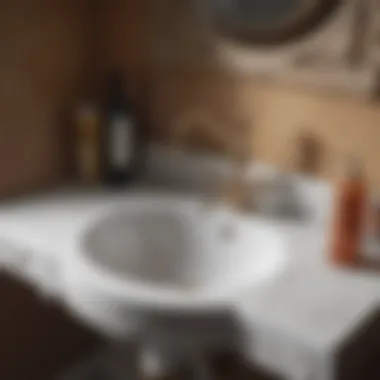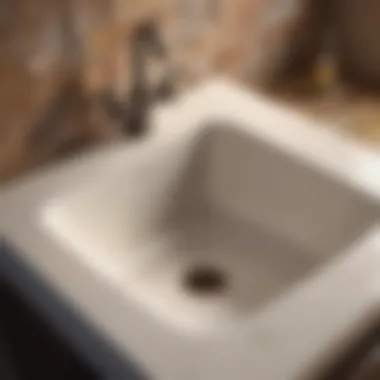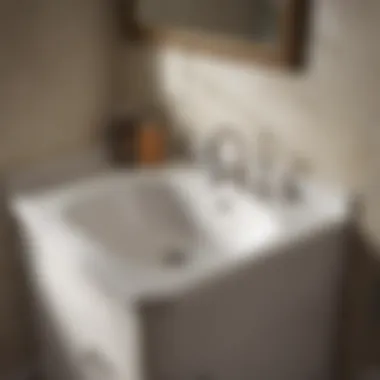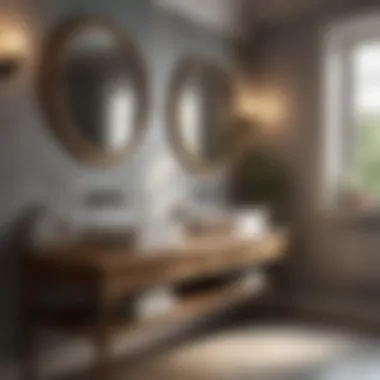Exploring Vintage Corner Bathroom Sinks: A Comprehensive Guide


Intro
Vintage corner bathroom sinks carry an undeniable charm that transforms ordinary spaces into stylish retreats. Their unique design caters to both space efficiency and aesthetic appeal. This guide aims to equip homeowners and DIY enthusiasts with the knowledge necessary to incorporate these sinks into contemporary bathroom designs. From understanding the historical context to exploring restoration techniques, every aspect of vintage corner sinks will be examined. Let’s dive into the heart of this timeless fixture.
Materials:
To get started with your vintage corner sink project, you need to gather a range of materials. Here is a clearly itemized list:
- Vintage corner sink: Choose an original or modern reproduction. Average size: 30x22 inches.
- Piping materials: Includes PVC or copper pipes (1 inch diameter for sink drain).
- Sink drain assembly: Compatible with your chosen sink, ideally a 1.5 inch drain size.
- Faucet: Consider a vintage-style faucet for aesthetic harmony. Make sure it fits the sink dimensions.
- Water supply connectors: Standard lengths typically range from 12 to 18 inches.
- Sealant: 100% silicone sealant for waterproofing. One standard tube is usually sufficient.
- Ceramic adhesive: For securing any loose tiles or the sink itself, if necessary.
- Paint/primer: Semi-gloss or enamel paint for touch-ups. One quart should cover a small area.
- Sandpaper: Various grits (start with 80, then 220 for finishing touches).
DIY Steps:
Detailed Instructions:
- Assess your Space: Measure the corner area where you plan to install the sink. Ensure clearance from walls and other fixtures.
- Prepare the Area: Clear out the existing sink and clean the surface. Ensure plumbing access is intact.
- Inspect Vintage Sink: Check for any cracks or damages that require attention before installation.
- Install plumbing: Align the drain assembly and connect it to the main drainage unit. This step is critical and needs careful attention.
- Position Sink: Carefully set the vintage corner sink into position, ensuring the drain aligns properly.
- Secure Sink: Use the ceramic adhesive or appropriate sealant. This protects against water damage.
- Add Functional Elements: Install the faucet and connect the water supply. Ensure connections are tight to avoid leaks.
- Seal Edges: Apply silicone sealant around the edges of the sink. This step is vital for waterproofing.
- Final Checks: Turn on the water supply and check for leaks in the connections.
Technical Aspects:
Tools Required:
- Adjustable wrench
- Screwdriver set
- Pipe cutter (optional for copper pipes)
- Level
- Measuring tape
- Caulking gun
Timing Specifics:
- Preparation: 1-2 hours
- Installation: 3-5 hours depending on plumbing complexities
Critical Techniques:
- Use a level when placing the sink to ensure it sits evenly.
- Protect surfaces with drop cloths to avoid damage during installation.
DIY Project Process:
Sequential Steps:
- Clear out the workspace and gather all materials.
- Measure and mark where the sink will go. This planning ensures precision during installation.
- Proceed with plumbing installation carefully, checking alignments regularly.
- After the sink is secured, apply waterproof sealant and paint touch-ups where necessary.
- Wait for the sealant to cure before using the sink (typically 24 hours).
Troubleshooting Tips:
- If you notice leaks, double-check all piping connections.
- Ensure the sealant is applied thoroughly around the edges to prevent water seepage.
- If the sink wobbles, double-check if it is level and adjust as necessary.
Important: Sourcing a vintage sink might take time. Consider online platforms or local antique stores. Take heed of measurements and condition to ensure a successful restoration.
Prolusion to Vintage Corner Bathroom Sinks
Vintage corner bathroom sinks offer a unique blend of functionality and style, carving out a niche within the broader landscape of bathroom fixtures. Understanding their significance is essential for housewives and homeowners who appreciate both aesthetics and practicality in their living spaces. These sinks not only maximize the utilization of often-overlooked corner areas but also serve as a statement piece, highlighting the character of your bathroom.


When discussing vintage corner sinks, it's crucial to consider their distinct characteristics that set them apart from conventional sink designs. Their compact nature suits smaller bathrooms, making it easier to integrate these sinks into existing layouts without compromising on design. Also, they evoke a sense of nostalgia that can harmonize with various interior design themes, from traditional to eclectic.
Moreover, vintage corner sinks can come in a variety of materials and styles, contributing to their allure and versatility. The significance of these sinks extends beyond mere aesthetic appeal; they embody an era of design that prioritizes both form and function. This article will explore their definition, historical context, and various design elements, giving readers insight into how to incorporate them into modern bathrooms effectively.
A deeper understanding of vintage corner bathroom sinks will help homeowners make informed choices when it comes to renovation or new construction. As we delve into the following sections, the multifaceted characteristics and advantages of these sinks will become clear, highlighting their invaluable role in enhancing bathroom functionality and style.
Design Elements of Vintage Corner Sinks
The design elements of vintage corner sinks play a critical role in defining the overall aesthetic and functionality of a bathroom. Understanding these components not only enhances the visual appeal but also aligns with modern needs for practicality and space efficiency. This guide dives into the significant design elements—shape and size variations, material considerations, and color schemes.
Shape and Size Variations
Vintage corner sinks come in numerous shapes and sizes, allowing for flexibility in design. Common shapes include triangular, round, or even asymmetrical forms. Each sink style can dramatically influence how a bathroom feels and operates. For instance, a triangular sink usually fits snugly in a tight corner, maximizing usable space.
Larger designs, such as those with a double basin, can provide added functionality, making them ideal for busy households. Smaller sinks, conversely, maintain a minimalist look and function better in compact spaces. The choice between these various forms reflects individual preferences and practical needs.
Material Considerations
The materials used in vintage corner sinks significantly contribute to their durability and aesthetic appeal. Traditionally, these sinks were made from porcelain, ceramic, or cast iron. Porcelain offers a classic look and is easy to clean, while ceramic provides vibrant color options and detailed patterns. Cast iron sinks deliver robustness and can often be found in vintage markets, sometimes requiring restoration.
When choosing materials, also consider modern substitutes like vitreous china, which combines traditional aesthetics with enhanced resilience. Each material presents unique advantages and drawbacks, and the selection process can impact both the sink's longevity and maintenance requirements.
Color Schemes and Finishes
Color schemes and finishes are also vital in the selection of vintage corner sinks. They can bring warmth or coolness into a bathroom, depending on personal taste and overall design schemes. Common colors include white for a classic look, while pastel hues offer a softer, vintage charm.
Finishes range from glossy to matte, each affecting the overall ambiance. Glossy finishes reflect light, creating a bright, open feel, while matte finishes provide a more subdued, minimalist aesthetic. It is essential to consider how the sink's color and finish will integrate with existing bathroom features like tiles and cabinetry.
"The right vintage sink can transform an ordinary bathroom into a sophisticated sanctuary."
In summary, the design elements of vintage corner sinks are fundamental to harmonizing historical charm with contemporary privacy needs. By carefully choosing shape, size, material, and color, homeowners can create a striking focal point within their bathrooms while ensuring efficiency and style.
Functional Advantages of Corner Sinks
Vintage corner bathroom sinks offer unique advantages beyond their aesthetic appeal. These sinks are a practical solution for small spaces, making them a popular choice for homeowners looking to optimize their bathroom's layout. This section will delve into two significant benefits that make corner sinks an appealing option: their space-saving solutions and ergonomic benefits.
Space-Saving Solutions
For many houses, especially those with limited square footage, every inch counts. Vintage corner sinks excel in this domain as they utilize otherwise wasted corner space. Placing a sink in the corner can free up wall and floor space, allowing for greater design options and improved flow within the bathroom. This arrangement not only maximizes the functionality of the room but also creates an open atmosphere.
When considering a vintage corner sink, homeowners can benefit from several features:
- Compact Size: These sinks typically come in smaller dimensions, which is perfect for tight areas.
- Versatility: Corner sinks can be fitted into a variety of layouts, seamlessly integrating with other fixtures like cabinets or shelving.
- Increased Circulation: By avoiding obstruction in pathways, a corner sink can lead to easier movement in the bathroom.
- Design Flexibility: This style allows additional features, such as storing bathing essentials or even displaying decorative items.
"Utilizing a corner for a sink is not just about practicality, it also inspires creativity in design."


Homeowners considering a renovation should take a close look at the corner of their bathrooms. A vintage corner sink can be just the element that transforms an awkward space into a stylish and functional part of the home.
Ergonomic Benefits
Ergonomics in bathroom design should not be overlooked, especially in spaces that are frequently used. Vintage corner sinks can provide several ergonomic advantages, making them not just visually appealing but also comfortable to use.
- Natural Positioning: Positioned in the corner, these sinks often allow users to maintain a more natural posture while using the sink. This can reduce strain on the back and neck, which can occur with traditional sink placements.
- Accessibility: Vintage corner sinks are often easier to reach for individuals with mobility challenges. This characteristic makes them a suitable choice for all ages and abilities in a household.
- Enhanced Workflow: The strategic placement of corner sinks can facilitate better access to other important elements in the bathroom, like your medicine cabinet or linen closet.
Selecting a vintage corner bathroom sink can be a step towards a more ergonomic and user-friendly bathroom space. Considering these practical advantages will help homeowners make informed decisions when designing or renovating their bathrooms.
Challenges in Sourcing Vintage Sinks
Sourcing vintage sinks presents a range of challenges that demand careful consideration. First, understanding the marketplace is crucial. Vintage bathroom fixtures are highly sought after, making them not only rare but potentially expensive. This scarcity can complicate the purchasing process. Homeowners must be aware of where to look and how to identify genuine pieces.
Identifying Authentic Pieces
When searching for vintage corner bathroom sinks, authenticity is key. There are unfortunately many reproductions and fakes in the market, making it important for buyers to know what to look for.
- Research is Essential: Knowledge of specific brands and their history can help authenticate a sink. Studying the manufacturing marks, styles, and materials used during the period can provide significant clues. For instance, older models often feature materials like cast iron or porcelain.
- Physical Inspection: If possible, inspect the sink personally. Look for imperfections that only age can bring. Authentic vintage pieces may have slight wear or inconsistencies in the finish, which can help differentiate them from modern replicas.
- Selllers' Reputation: Buying from reputable dealers or auctions increases the chance of obtaining a genuine vintage sink. Of course, online platforms also offer many options, but buyer beware, as the risk of encountering counterfeit products is higher.
Restoration vs. Replacement
Another significant consideration is whether to restore an authentic vintage sink or replace it with a modern equivalent. Each choice has its own merits and drawbacks.
- Restoration Benefits: Keeping the original sink can preserve historical value and aesthetic charm. Restoration can often reveal the true beauty of these pieces, enhancing the character of a bathroom. Skilled artisans can repair cracks, chips, and finish discoloration, resulting in a restore that feels timeless. Additionally, restoring is often more sustainable, as it minimizes waste.
- Replacement Factors: On the other hand, replacing a vintage sink may be the only option if the damage is extensive or the restoration costs exorbitantly high. Modern sinks can sometimes offer improved functionality and easier maintenance. Moreover, they may integrate better with contemporary plumbing setups, reducing future headaches.
Ultimately, the decision between restoration and replacement depends on personal values, budget, and the specific condition of the vintage sink. Both paths require thoughtful consideration to ensure homeowners make a choice that suits their needs.
Integrating Vintage Sinks into Modern écor
Integrating vintage corner sinks into modern bathroom décor is not just about placing an antique item in a sleek environment. It represents a significant design approach that harmonizes the old with the new, enabling homeowners to express individuality and history in their spaces. Vintage sinks can act as focal points, while also providing functional benefits that enhance everyday use. By carefully selecting complementary styles and accessories, one can achieve a cohesive design that reflects character and charm.
Complementary Bathroom Styles
Vintage corner sinks lend themselves well to various bathroom styles. Their versatility allows them to fit seamlessly into many aesthetics, including:
- Farmhouse Style: The rustic appeal of vintage sinks complements the warm, cozy feel of farmhouse décor. Wooden cabinetry and soft colors can enhance the vintage look and feel.
- Industrial Design: The rawness of industrial design pairs well with the smooth lines of vintage sinks. Metal accents and exposed piping can create a striking visual contrast.
- Art Deco: The glamour of the Art Deco period aligns perfectly with the details often found in vintage sinks. Combine geometrical patterns with metallic finishes for a sophisticated look.
- Modern Boho: Incorporating a vintage sink into a modern bohemian space adds inimitable character. Pair it with earth tones and eclectic decor elements for a relaxed vibe.
Consider the existing elements of your bathroom when selecting a vintage sink. A sink from a completely different style may clash rather than achieve unity. Choosing pieces that resonate with the current color palette or materials will result in harmony.
Accessories and Fixtures
The accessories and fixtures that accompany a vintage sink play a pivotal role in its integration into modern décor. It’s crucial to select items that not only serve functional purposes but also enhance the overall design. Here are a few key considerations:
- Faucets: Opt for vintage-style faucets that match the sink in both functionality and aesthetics. Brands like Delta and Moen offer options that can achieve the right look without compromising modern efficiency.
- Lighting: Ambient and task lighting should complement the vintage sink. Consider sconces with historical designs or retro pendant lights. These choices can make the sink the standout feature.
- Mirrors: A well-chosen mirror can elevate the look of a vintage sink. Choose frames that reflect the era of the sink. For example, a distressed wooden frame may pair nicely with a farmhouse sink.
- Storage Solutions: Modern storage can blend with vintage styles through creative cabinetry. Open shelving showcasing vintage decor items can enhance the overall aesthetic and offer practicality.


"Incorporating vintage elements in modern design creates a unique narrative that resonates with personal history. It encourages sustainability and a thoughtful approach to design."
These combinations allow for a personal touch in any bathroom, making it not just beautiful but practical too. The goal is to seamlessly blend vintage character with modern functionality, creating a space that is uniquely yours.
Sustainability and Vintage Design
In the context of modern interior design, the marriage of sustainability and vintage aesthetics holds significant relevance. As homeowners and designers increasingly prioritize sustainable practices, vintage corner bathroom sinks stand out as a unique solution. These sinks not only bring character to a bathroom but also contribute to environmental considerations that are critical in today's design philosophy. The importance of sustainability relates to how vintage items can reduce waste and repurpose materials that might otherwise end up in landfills.
Environmental Impact
The environmental impact of choosing vintage corner sinks is multifaceted. Vintage sinks are often made from materials like cast iron or porcelain, which are durable and long-lasting. By utilizing these materials, one is engaging in a practice that reduces the demand for new products. When one opts for a vintage piece, it represents a smaller carbon footprint compared to manufacturing new sinks.
Furthermore, purchasing vintage items encourages local economies. Many vintage sinks are sold through local antique shops or flea markets, reducing the environmental costs associated with shipping new products from factories.
"Choosing vintage is not only a design choice; it's a step towards sustainable living."
Lifecycle of Vintage Materials
Understanding the lifecycle of vintage materials is crucial for appreciating their value. Vintage sinks often carry a history, embodying craftsmanship that is seldom seen in modern manufacturing. Older materials, such as glazed ceramics, tend to be more resilient against wear than newer alternatives. As a result, they remain functional for decades, or even centuries.
Moreover, as these sinks age, they often develop a unique patina or finish that gives each piece its own character. On the other hand, modern materials frequently aim for quick production processes that sacrifice durability for style.
Taking care of vintage materials means investing in their longevity. Cleaning and maintaining these sinks with gentle products ensures they can serve future generations. By integrating vintage elements into contemporary design, homeowners contribute to a circular economy, one focused on extending the lifecycle of materials rather than discarding them.
Innovative Trends in Bathroom Design
Bathroom design has evolved significantly, and one of the fascinating aspects is the resurgence of vintage elements. This section highlights innovative trends that merge traditional aesthetics with modern functionality. Understanding these trends is crucial for homeowners who wish to create a unique and stylish environment while also considering practicality and sustainability.
Current Trends Incorporating Vintage Elements
The integration of vintage elements into contemporary bathroom design has become increasingly popular. Homeowners are drawn to the charm and character that vintage pieces offer, especially corner sinks, which efficiently use space without sacrificing style. Some current trends include:
- Mixing Styles: Combining vintage sinks with modern fixtures can create a balance between old and new. For example, pairing a classic ceramic corner sink with sleek, contemporary faucets adds visual interest.
- Restoration of Old Materials: The practice of restoring vintage materials is on the rise. Many homeowners opt to refinish antique sinks, retaining their original character while ensuring they meet modern standards.
- Color and Pattern Integration: Vintage designs often feature unique color palettes and patterns. Incorporating these elements into a bathroom can enhance its aesthetic appeal. Vintage china sinks often sport intricate designs and shades that bring warmth and personality.
- Sustainability: Increasing awareness of environmental issues has spurred a trend towards using reclaimed materials and fixtures. Vintage sinks are not only sustainable but also reduce wastage, making them a perfect choice for eco-conscious homeowners.
The blend of these styles results in a bathroom that tells a story while also being functional.
Future Directions for Vintage Sinks
Looking ahead, the future of vintage corner bathroom sinks seems promising as trends continue to develop. Several foreseeable directions include:
- Smart Technology: As technology advances, there may be a shift towards integrating smart features within vintage designs. For instance, adding low-flow faucets to conserve water without compromising the vintage aesthetic could become increasingly common.
- Custom Designs: Homeowners may seek more custom options for vintage sinks, allowing for personalization to fit their unique style. This could lead to more artisans creating bespoke pieces that marry vintage design principles with modern craftsmanship.
- Increased Focus on Heritage: There might be a growing emphasis on understanding the history and origin of vintage sinks. Homeowners may become more interested in the stories behind their fixtures, leading to a deeper appreciation of craftsmanship and heritage.
- Sustainable Manufacturing: As sustainability becomes a priority in design, the production of vintage-inspired sinks might involve more eco-friendly processes. Manufacturers may focus on creating replicas of vintage styles using sustainable materials and practices.
In summary, the trends in bathroom designs show a distinctive inclination toward vintage elements, specifically corner sinks. They not only serve functional needs but also contribute to a narrative rich in history and personal expression, enticing homeowners to explore new dimensions in their bathroom spaces.
Ending
The conclusion serves as a crucial component of the article, encapsulating the overall significance of vintage corner bathroom sinks. Understanding their role is beneficial for homeowners seeking to marry functionality with aesthetics in their spaces. Vintage sinks are not only decoratively appealing but also represent a unique blend of heritage and sustainability. Readers can accurately appreciate the historical context they provide while recognizing their practical advantages. This makes vintage corner sinks an excellent choice for those looking to upgrade their bathrooms without compromising on style.
Recap of Key Points
To summarize the important elements discussed in the article:
- Definition and Characteristics: Vintage corner bathroom sinks are defined by their unique shape, and they fit snugly in corners, maximizing space.
- Historical Context: These sinks have evolved through various design movements, reflecting changes in interior design trends.
- Design Elements: Factors like shape, size, materials, and colors play a central role in their aesthetic appeal. Popular materials include porcelain and enamel.
- Functional Advantages: The space-saving features and ergonomic benefits make them ideal for smaller bathrooms.
- Challenges: Homeowners often face hurdles in sourcing authentic pieces and deciding between restoration and replacement.
- Integrating into Modern Decor: Vintage sinks can be harmoniously incorporated into contemporary styles, supported by matching accessories and fixtures.
- Sustainability: Using vintage sinks reduces waste and appreciates the history embedded in old materials.
- Trends: Current design trends show a resurgence in integrating vintage elements within modern bathroom spaces.







